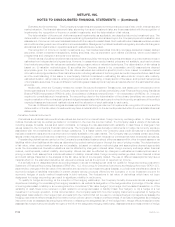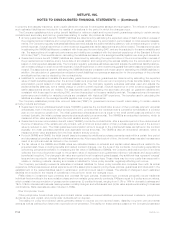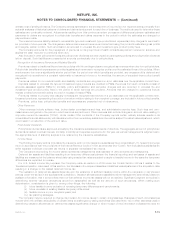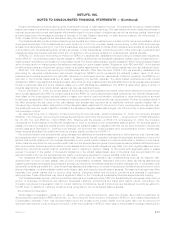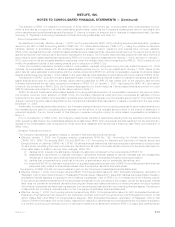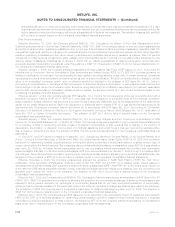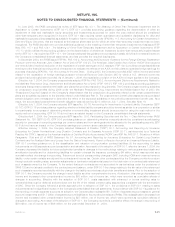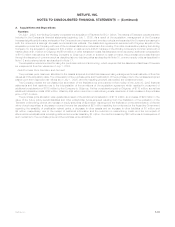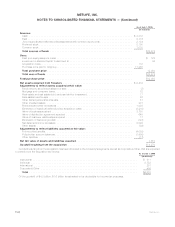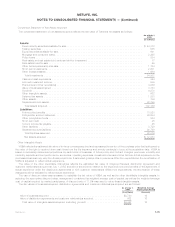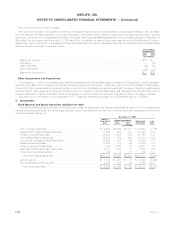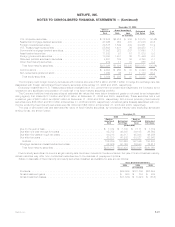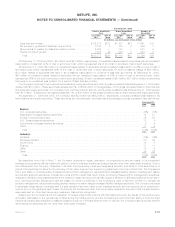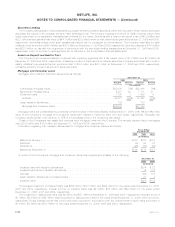MetLife 2006 Annual Report Download - page 103
Download and view the complete annual report
Please find page 103 of the 2006 MetLife annual report below. You can navigate through the pages in the report by either clicking on the pages listed below, or by using the keyword search tool below to find specific information within the annual report.embedded call option, in which the underlying is an interest rate or interest rate index, that can accelerate the settlement of a debt
host financial instrument should not be bifurcated and fair valued if the right to accelerate the settlement can be exercised only by the
debtor (issuer/borrower) and the investor will recover substantially all of its initial net investment. The adoption of Issues B38 and B39
did not have a material impact on the Company’s consolidated financial statements.
Other Pronouncements
Effective November 15, 2006, the Company adopted SAB No. 108, Considering the Effects of Prior Year Misstatements when
Quantifying Misstatements in Current Year Financial Statements (“SAB 108”). SAB 108 provides guidance on how prior year misstatements
should be considered when quantifying misstatements in current year financial statements for purposes of assessing materiality. SAB 108
requires that registrants quantify errors using both a balance sheet and income statement approach and evaluate whether either approach
results in quantifying a misstatement that, when relevant quantitative and qualitative factors are considered, is material. SAB 108 permits
companies to initially apply its provisions by either restating prior financial statements or recording a cumulative effect adjustment to the
carrying values of assets and liabilities as of January 1, 2006 with an offsetting adjustment to retained earnings for errors that were
previously deemed immaterial but are material under the guidance in SAB 108. The adoption of SAB 108 did not have a material impact on
the Company’s consolidated financial statements.
Effective January 1, 2006, the Company adopted prospectively Emerging Issues Task Force (“EITF”) Issue No. 05-7, Accounting for
Modifications to Conversion Options Embedded in Debt Instruments and Related Issues (“EITF 05-7”). EITF 05-7 provides guidance on
whether a modification of conversion options embedded in debt results in an extinguishment of that debt. In certain situations, companies
maychangethetermsofanembeddedconversionoptionaspartofadebt modification. The EITF concluded that the change in the fair
valueofanembeddedconversionoptionuponmodificationshouldbeincludedintheanalysisofEITFIssueNo.96-19,Debtor’s
Accounting for a Modification or Exchange of Debt Instruments, to determine whether a modification or extinguishment has occurred and
that a change in the fair value of a conversion option should be recognized upon the modification as a discount (or premium) associated
with the debt, and an increase (or decrease) in additional paid-in capital. The adoption of EITF 05-7 did not have a material impact on the
Company’s consolidated financial statements.
Effective January 1, 2006, the Company adopted EITF Issue No. 05-8, Income Tax Consequences of Issuing Convertible Debt with a
Beneficial Conversion Feature (“EITF 05-8”). EITF 05-8 concludes that: (i) the issuance of convertible debt with a beneficial conversion
feature results in a basis difference that should be accounted for as a temporary difference; and (ii) the establishment of the deferred tax
liability for the basis difference should result in an adjustment to additional paid-in capital. EITF 05-8 was applied retrospectively for all
instruments with a beneficial conversion feature accounted for in accordance with EITF Issue No. 98-5, Accounting for Convertible
Securities with Beneficial Conversion Features or Contingently Adjustable Conversion Ratios, and EITF Issue No. 00-27, Application of
Issue No. 98-5 to Certain Convertible Instruments. The adoption of EITF 05-8 did not have a material impact on the Company’s
consolidated financial statements.
Effective January 1, 2006, the Company adopted SFAS No. 154, Accounting Changes and Error Corrections, a replacement of APB
Opinion No. 20 and FASB Statement No. 3 (“SFAS 154”). SFAS 154 requires retrospective application to prior periods’ financial statements
for a voluntary change in accounting principle unless it is deemed impracticable. It also requires that a change in the method of
depreciation, amortization, or depletion for long-lived, non-financial assets be accounted for as a change in accounting estimate rather
than a change in accounting principle. The adoption of SFAS 154 did not have a material impact on the Company’s consolidated financial
statements.
In June 2005, the EITF reached consensus on Issue No. 04-5, Determining Whether a General Partner, or the General Partners as a
Group, Controls a Limited Partnership or Similar Entity When the Limited Partners Have Certain Rights (“EITF 04-5”). EITF 04-5 provides a
framework for determining whether a general partner controls and should consolidate a limited partnership or a similar entity in light of
certain rights held by the limited partners. The consensus also provides additional guidance on substantive rights. EITF 04-5 was effective
after June 29, 2005 for all newly formed partnerships and for any pre-existing limited partnerships that modified their partnership
agreements after that date. For all other limited partnerships, EITF 04-5 required adoption by January 1, 2006 through a cumulative effect
of a change in accounting principle recorded in opening equity or applied retrospectively by adjusting prior period financial statements. The
adoption of the provisions of EITF 04-5 did not have a material impact on the Company’s consolidated financial statements.
Effective November 9, 2005, the Company prospectively adopted the guidance in FASB Staff Position (“FSP”) No. FAS 140-2,
Clarification of the Application of Paragraphs 40(b) and 40(c) of FAS 140 (“FSP 140-2”). FSP 140-2 clarified certain criteria relating to
derivatives and beneficial interests when considering whether an entity qualifies as a QSPE. Under FSP 140-2, the criteria must only be met
at the date the QSPE issues beneficial interests or when a derivative financial instrument needs to be replaced upon the occurrence of a
specified event outside the control of the transferor. The adoption of FSP 140-2 did not have a material impact on the Company’s
consolidated financial statements.
Effective July 1, 2005, the Company adopted SFAS No. 153, Exchanges of Nonmonetary Assets, an amendment of APB Opinion No. 29
(“SFAS 153”). SFAS 153 amended prior guidance to eliminate the exception for nonmonetary exchanges of similar productive assets and
replaced it with a general exception for exchanges of nonmonetary assets that do not have commercial substance. A nonmonetary
exchange has commercial substance if the future cash flows of the entity are expected to change significantly as a result of the exchange.
The provisions of SFAS 153 were required to be applied prospectively for fiscal periods beginning after June 15, 2005. The adoption of
SFAS 153 did not have a material impact on the Company’s consolidated financial statements.
Effective July 1, 2005, the Company adopted EITF Issue No. 05-6, Determining the Amortization Period for Leasehold Improvements
(“EITF 05-6”). EITF 05-6 provides guidance on determining the amortization period for leasehold improvements acquired in a business
combination or acquired subsequent to lease inception. As required by EITF 05-6, the Company adopted this guidance on a prospective
basis which had no material impact on the Company’s consolidated financial statements.
F-20 MetLife, Inc.
METLIFE, INC.
NOTES TO CONSOLIDATED FINANCIAL STATEMENTS — (Continued)


